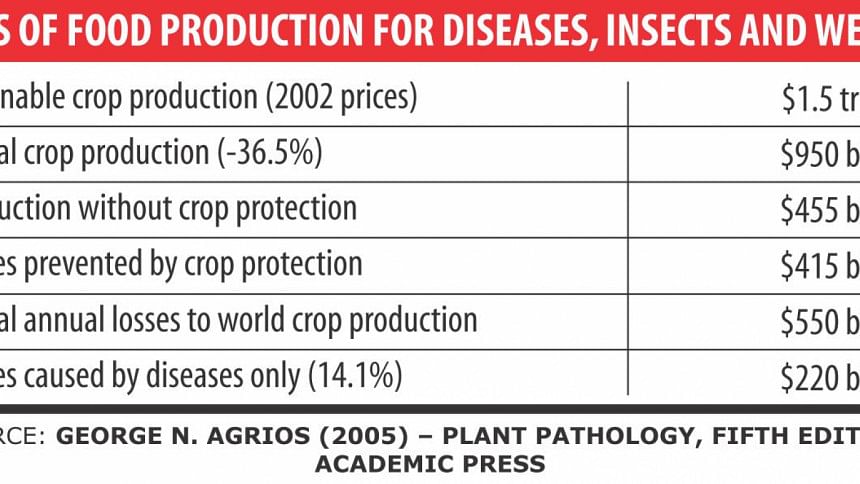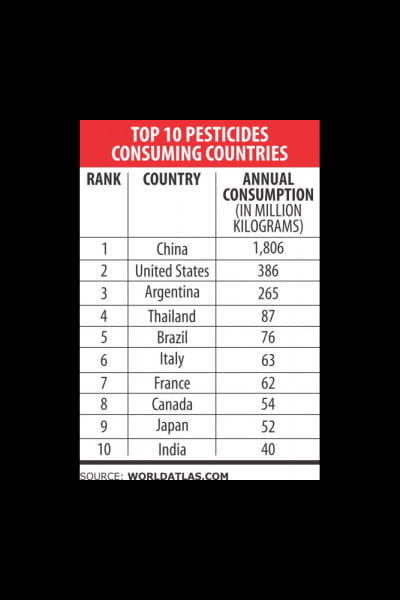Crop protection industry: a contributor in disguise

Nur Hossain, a veteran farmer from Purbo Begunbari of Thakurgaon district, cultivated 12 acres of land last boro season with two of the country's most popular rice varieties: BR-28 and 29.
Everything was progressing as expected, but few days before the harvest Hossain noticed that the panicles were becoming straw-coloured, and in time, they started dropping to the ground.
His whole field got affected badly, leaving him with only 50 percent of the yields, which he normally used to get.
This heartbreaking account was the story of many farmers across the country last boro season. Consequently, the country's overall rice production was badly impacted, which led to the rice price spiral.

This disaster occurred due to a deadly disease called Blast, caused by an obnoxious fungus named Magnaporthe Oryzae.
There are 30,000 species of harmful weeds, 3,000 species of deadly nematodes, 10,000 species of plant-eating insects and numerous dangerous fungus against which the crops have to fight for their survival. These harmful weeds, insects and fungi are commonly referred as pests.
A study revealed that globally an average of 35 percent of the potential crop yield is lost to pests and diseases. Another study showed the loss of food production due to diseases, insects and weeds.
Crop protection (CP) products commonly known as pesticides or agrochemicals are used to control the harmful pests.
There are different categories of pesticides like insecticides for controlling insects, herbicides for managing weeds, fungicides for protecting the plants from various diseases.
Sanitisers, plant growth regulators (PGR), rodenticides and so on are also considered as pesticides.
Besides controlling the deadly pests, some CP products have crop enhancement (CE) properties that enhance crops' vigour and improve flower and fruits settings ability, resulting in more yields.
These chemistries also help the grains or fruits to become shinier and bolder and eventually facilitate the farmers to obtain better market price for their produces.
Consumption of pesticides globally is about two million tonnes per year, according to a report.
Of the amount, Europe alone consumes 45 percent, the US 25 percent and the rest of the world the remaining 30 percent.
Herbicides account for 48 percent of total pesticides applied globally, followed by insecticides at 30 percent and fungicides at 18 percent.
China is the largest pesticide-consuming country in the world, followed by the US and Argentina.
Statistics show that China also leads the table in per hectare pesticide usage with around 14.82 kg, followed by Japan at 11.85 kg.
Pesticide consumption in per hectare of land in some of the other developed countries is: France 3.9 kg, Germany 3.8 kg, the UK 2.93 kg, Canada 1.45 kg, and the US 2.42 kg.
In Bangladesh, it is about 1.86 kg. Total pesticide consumption in 2016 was about 35,000 tonnes, of which 14,000 tonnes were the active ingredients, according to data from the Bangladesh Crop Protection Association (BCPA).
The CP industry is playing a critical role in the country's agriculture sector in terms of enhancing food production and thus contributing to the overall economy. The present market value of the industry is about $250 million.
In the last ten years, the industry has experienced nearly 10 percent cumulative annual growth. It is expected to grow at a similar pace, if not better, since the country needs to boost its agriculture productivity to ensure food security for its increasing population.
At present, there are about 350 companies working in the sector, employing roughly 25,000. Approximately 50,000 dealers across the country are involved in selling pesticides.
Despite its significant contribution to the country's agriculture, the industry often fails to get due recognition; rather, wrong perceptions exist about pesticides in the minds of many.
Sometimes, preservatives like formalin or chemicals like carbide are mixed up with agrochemicals.
But, the industry is highly regulated and governed by law of the land: the Pesticides (Amendment) Act, 2009 which originated from Pesticide Ordinance, 1971, regulates the import, manufacture, formulation, sale, distribution and the use of pesticides.
Recently, the cabinet endorsed the Balai Nashak (Pesticide) Act 2017.
To deal with the wrong perceptions, the BCPA along with the leading companies should engage with different stakeholders to inform them of the facts.
They need to keep on promoting integrated pest management (IPM), which is a well-recognised scientific means recommended by scientists and competent authorities to handle pest problems.
IPM does endorse the usage of chemicals or pesticides along with other ways and means. Growers should be adequately trained on the safety measures to be taken during pesticide application to avoid any adverse impact.
Another acute challenge for the sector is the counterfeit and adulterated products. Farmers often get cheated with fake chemicals.
The concerned regulatory authorities along with the law enforcing agencies need to strengthen their vigilance and bring those unscrupulous peddlers to justice to safeguard farmers' interests.
This is a highly technical sector that requires sound knowledge. To ensure judicious use of pesticide, there is no alternate to imparting the knowledge across the value chain, from the dealers to the farmers.
The concerned stakeholders should join hands for extensive training and education, which would benefit the country's agriculture significantly as well as clear the wrong perceptions about pesticides.
The writer is chairman and managing director of BASF Bangladesh Limited.

 For all latest news, follow The Daily Star's Google News channel.
For all latest news, follow The Daily Star's Google News channel. 



Comments